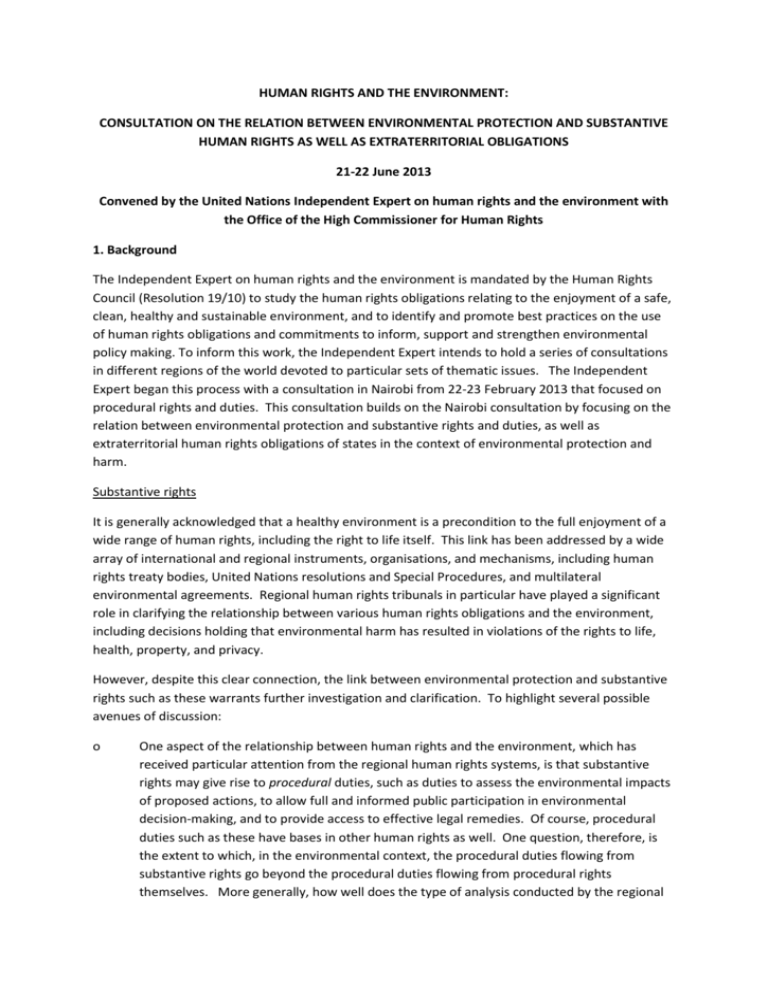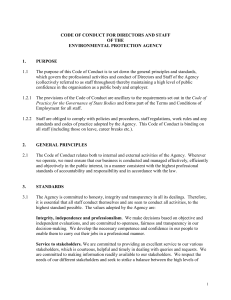Concept Note and Programme - United Nations Mandate on Human
advertisement

HUMAN RIGHTS AND THE ENVIRONMENT: CONSULTATION ON THE RELATION BETWEEN ENVIRONMENTAL PROTECTION AND SUBSTANTIVE HUMAN RIGHTS AS WELL AS EXTRATERRITORIAL OBLIGATIONS 21-22 June 2013 Convened by the United Nations Independent Expert on human rights and the environment with the Office of the High Commissioner for Human Rights 1. Background The Independent Expert on human rights and the environment is mandated by the Human Rights Council (Resolution 19/10) to study the human rights obligations relating to the enjoyment of a safe, clean, healthy and sustainable environment, and to identify and promote best practices on the use of human rights obligations and commitments to inform, support and strengthen environmental policy making. To inform this work, the Independent Expert intends to hold a series of consultations in different regions of the world devoted to particular sets of thematic issues. The Independent Expert began this process with a consultation in Nairobi from 22-23 February 2013 that focused on procedural rights and duties. This consultation builds on the Nairobi consultation by focusing on the relation between environmental protection and substantive rights and duties, as well as extraterritorial human rights obligations of states in the context of environmental protection and harm. Substantive rights It is generally acknowledged that a healthy environment is a precondition to the full enjoyment of a wide range of human rights, including the right to life itself. This link has been addressed by a wide array of international and regional instruments, organisations, and mechanisms, including human rights treaty bodies, United Nations resolutions and Special Procedures, and multilateral environmental agreements. Regional human rights tribunals in particular have played a significant role in clarifying the relationship between various human rights obligations and the environment, including decisions holding that environmental harm has resulted in violations of the rights to life, health, property, and privacy. However, despite this clear connection, the link between environmental protection and substantive rights such as these warrants further investigation and clarification. To highlight several possible avenues of discussion: o One aspect of the relationship between human rights and the environment, which has received particular attention from the regional human rights systems, is that substantive rights may give rise to procedural duties, such as duties to assess the environmental impacts of proposed actions, to allow full and informed public participation in environmental decision-making, and to provide access to effective legal remedies. Of course, procedural duties such as these have bases in other human rights as well. One question, therefore, is the extent to which, in the environmental context, the procedural duties flowing from substantive rights go beyond the procedural duties flowing from procedural rights themselves. More generally, how well does the type of analysis conducted by the regional human rights mechanisms apply at the global level? Is it possible to conclude that procedural duties follow from substantive rights, in the environmental context, pursuant to the UN human rights treaties as well? o Apart from procedural duties, substantive rights may also give rise to certain minimum substantive environmental standards that apply regardless of whether procedural requirements are followed. For example, the Committee on Economic, Social and Cultural Rights, in its general comment No. 15 (2002) on the right to water, has construed the right to health as encompassing “taking steps on a non-discriminatory basis to prevent threats to health from unsafe and toxic water conditions. For example, States parties should ensure that natural water resources are protected from contamination by harmful substances and pathogenic microbes” (para. 8). The questions here have to do with the precise content of such substantive duties. What standards of environmental quality do they require? Do they obligate States to prevent any contamination of natural resources? If not, what constraints do they impose on State discretion? Are they obligations of result, or of due diligence? o How, if at all, do the obligations arising from substantive human rights apply differently when the source of environmental harm is a non-State actor? o How do the obligations arising from substantive human rights apply to environmental harm that is threatened but not certain? How imminent must a threat be in order to trigger duties? o Although the UN human rights treaties do not include an explicit right to a healthy environment, many regional instruments and national constitutions do recognize such a right. Where this right is recognized, what duties, if any, does it add to those imposed by other rights, such as the rights to life and health? How does this right relate to such other rights? These questions illustrate, but do not exhaust, the possible topics of discussion. In these areas and throughout the discussion, an emphasis will be on identifying whether obligations are lex lata or lex ferenda. In the latter case, the obligations may still be relevant to the “best practices” part of the mandate. Extraterritorial obligations The extraterritorial application of human rights obligations is a recurring source of controversy in many contexts throughout human rights law. This issue is of particular importance in the environmental context, in the light of the number and intensity of transboundary and global environmental threats to the full enjoyment of human rights. Indeed, such problems have given rise to much of international environmental law, from bilateral and regional agreements to multilateral environmental agreements on global challenges such as marine pollution, ozone depletion and climate change. The application of human rights law to transboundary and global environmental harm therefore requires consideration of questions regarding the extraterritorial reach of human rights norms. In other words, what human rights obligations and duties do states have with respect to environmental harm outside of their territory? Those questions are often legally and politically complex, not least because human rights treaties employ varying language to define the scope of their application. Topics of discussion will include: o Clarifying how the substantive and procedural duties identified in the preceding part of the consultation, and in the Nairobi consultation in February 2013, apply to transboundary and global environmental harm, taking into account the different jurisdictional language employed by different human rights treaties; o Examining whether a duty of international cooperation helps to provide concrete obligations with respect to transboundary environmental issues; o Addressing the application of such duties to global environmental problems where no one state is solely responsible for causing transboundary harm, such as in the area of climate change. As above, the discussion will range beyond these issues to others raised by the participants. And, again, an emphasis will be on identifying whether obligations are lex lata or lex ferenda, with the understanding that the latter obligations may still be relevant to the “best practices” part of the mandate. 2. Objectives The objectives of this consultation are to: i) Map the environmental obligations arising from substantive human rights, including in the context of transboundary and global environmental protection and harm; ii) Identify relevant policies and practices at international, regional and national levels to help inform the clarification of both topics of the consultation; iii) Offer a platform of dialogue between participants, including facilitating the exchange of experiences, knowledge, and lessons learned; and iv) Increase awareness of a human rights based approach to environmental policy development and protection. 3. Outputs This consultation will inform the work of the Independent Expert in studying human rights obligations and best practices in their use, and in particular the Independent Expert’s next report to the Human Rights Council to be presented in March 2014. 4. Participants The consultation will gather approximately 10 participants with a high level of expertise in the areas covered by the consultation. Participants will be invited in their personal capacity, rather than as representatives of their respective institutions. The goal of the consultation is to have a high-level discussion of the issues. 5. Format As the attached programme indicates, the consultation will be held over 2 days and will be structured around various thematic sessions. The Chatham House rules shall be observed during the discussions (i.e. points raised during the discussion will not be ascribed to any specific participant), to encourage those contributing to do so as candidly as possible. The consultation will take place in English. 6. Security The security protocol for entry into Palais Wilson will be shared with participants in due course. PROGRAMME HUMAN RIGHTS AND THE ENVIRONMENT: CONSULTATION ON THE RELATION BETWEEN ENVIRONMENTAL PROTECTION AND SUBSTANTIVE HUMAN RIGHTS AS WELL AS EXTRATERRITORIAL OBLIGATIONS 21-22 June 2013 Room 3060 Palais Wilson, Geneva Day 1 – Friday 21 June 9:00-9:15 Introduction and Overview Introduction of participants Objectives of the expert consultation and overview of the programme Professor John Knox, UN Independent Expert on human rights and the Environment 9:15- 10:45 SESSION 1: Procedural duties flowing from substantive rights in the context of environmental protection One aspect of the relationship between human rights and the environment, which has received particular attention from the regional human rights systems, is that substantive rights may give rise to procedural duties, such as duties to assess the environmental impacts of proposed actions, to allow full and informed public participation in environmental decision-making, and to provide access to effective legal remedies. Of course, procedural duties such as these have bases in other human rights as well. Questions to be addressed include: To what extent, in the environmental context, do the procedural duties flowing from substantive rights go beyond the procedural duties flowing from procedural rights themselves? How well does the type of analysis conducted by the regional human rights mechanisms apply at the global level? Is it possible to conclude that procedural duties follow from substantive rights, in the environmental context, pursuant to the UN human rights treaties as well as regional agreements? 10:45-11:00 Break 11:00-12:30 SESSION 2: The content of substantive duties with respect to environmental protection Apart from procedural duties, substantive rights may also give rise to certain minimum substantive environmental standards that apply regardless of whether procedural requirements are followed. Questions that will be addressed include: 12:30-14:30 What standards of environmental quality do substantive duties require? Do they obligate States to prevent any contamination of natural resources? If not, what constraints do they impose on State discretion? Are they obligations of result, or of due diligence? Lunch (Please note that this is an extended lunch break to allow participants time to process their per diem. Instructions will be provided by OHCHR staff prior to lunch.) 14:30 -16:00 SESSION 3: Obligations regarding non-State actors and obligations in the context of uncertainty This session will address the following questions: How, if at all, do the obligations arising from substantive human rights apply differently when the source of environmental harm is a non-State actor? How do the obligations arising from substantive human rights apply to environmental harm that is threatened but not certain? How imminent must a threat be in order to trigger duties? 16:00-16:15 Break 16:15-17:45 SESSION 4: Exploring the duties created by a substantive right to a healthy environment in relation to other substantive rights Although the UN human rights treaties do not include an explicit right to a healthy environment, many regional instruments and national constitutions do recognize such a right. Questions that will be addressed include: Where this right is recognized, what duties, if any, does it add to those imposed by other rights, such as the rights to life and health? How does this right relate to such other rights? 17:45-18:00 Closing remarks 19:30 Dinner A group dinner will be planned. Details will be shared prior to the consultation. Day 2- Saturday 22 June 9:00-11:00 SESSION 5: Application of substantive and procedural duties to transboundary harm This session will seek to clarify how any substantive and procedural duties identified in the preceding part of the consultation, and in the Nairobi consultation in February 2013, apply to transboundary and global environmental harm, taking into account the different jurisdictional language employed by different human rights treaties. 11:00-11:15 Break 11:15-13:00 SESSION 6: The duty of international cooperation in the context of transboundary environmental harm Examining whether a duty of international cooperation helps to provide concrete obligations with respect to transboundary environmental issues; 13:00-14:30 Lunch We will be reserving a restaurant for the group to have lunch. Please note that participants will be responsible for paying for lunch from their per diem allowance. 14:30-16:00 SESSION 7: Global environmental problems where multiple states are causing transboundary harm This session will address the application of extraterritorial duties to global environmental problems where no one state is solely responsible for causing transboundary harm, such as in the area of climate change. 16:00-16:30 Closing remarks






